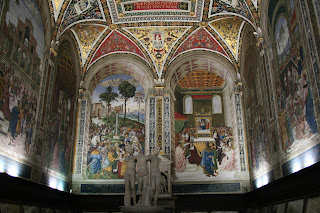Siena - The Piccolomini Library
Siena, a medieval town in Tuscany, is not only the home of the infamous Palio races but of a cathedral (duomo) that would grace any of the larger cities of Rome. Charles Dickens described it as “picturesque inside and out.”[1] The façade of the cathedral is a mixture of Gothic and Romanesque styles with ornately styled pinnacles and gargoyles sitting atop a polychrome marble base. What is surprising about Dickens’ comments on the cathedral is that he does not mention what is to my mind the cathedral’s main attraction – the Piccolomini Library.
Situated on the left hand side of the nave the library was built in 1492 on the order of the Bishop of Siena, Francesco Piccolomini, later Pope Pius III, to honour his uncle Pope Pius II and house his collection of manuscripts and books. Pius II, Enea Piccolomini, was Siena’s favourite son and the frescoes that line the walls tell the story of his life. Ten frescoes in total, painted by Pinturicchio and his assistants, are amazingly detailed and the vibrancy of colours is as if they had been painted the day before.
Each of the frescoes is labelled with a Latin inscription, taken from the pope's biography by the humanist writer Giovanni Antonio Campano. The scenes depicted are:
1. Departure for the Council of Basel on a white steed
2. Oration as envoy before King James I of Scotland
3. Crowned poet laureate by Holy Roman Emperor Frederick III
4. Subjugation to Pope Eugenius IV
5. As Archbishop of Siena, presenting Eleanor of Portugal to Frederick III at the Comollia gate in Siena
6. Nomination as cardinal by Callisto III
7. Election as Pope Pius II
8. Presiding over the Congress of Mantua, at which he proclaims a crusade
9. Canonizing St. Catherine of Siena
10. Reaching Ancona, where he would wait in vain for the Venetian fleet before setting out on Crusade against the Turks
The first fresco shows not only the young Enea Piccolomini but storm clouds and a rainbow. These natural occurrences were rarely, if ever, shown in works before this time.
The illuminated manuscripts of the cathedral’s sacristy sit beneath the frescoes. The intricate and exquisite detailing of the pictures and decoration on each page is truly delightful to see.
The vibrant colours of this room, with its captivating artwork can mean that the visitor almost misses the Three Graces that stand in the centre of the room. These pre-Christian figures and the mythological scenes, grotesques and putti on the ceiling have led to some criticism of the pagan content of a room in a cathedral. But that would to be miss the point of the room – to home the manuscript and literary works of Pope Pius II who was, after all, described as a humanist pope. Pius II was proof that humanism and religion could sit together and the Piccolomini Library remains as a testament to this.
If you visit Siena’s duomo do not forget to take in the beauty of this room – the Piccolomini Library.
[1] Pictures from Italy, Charles Dickens






Comments
Post a Comment